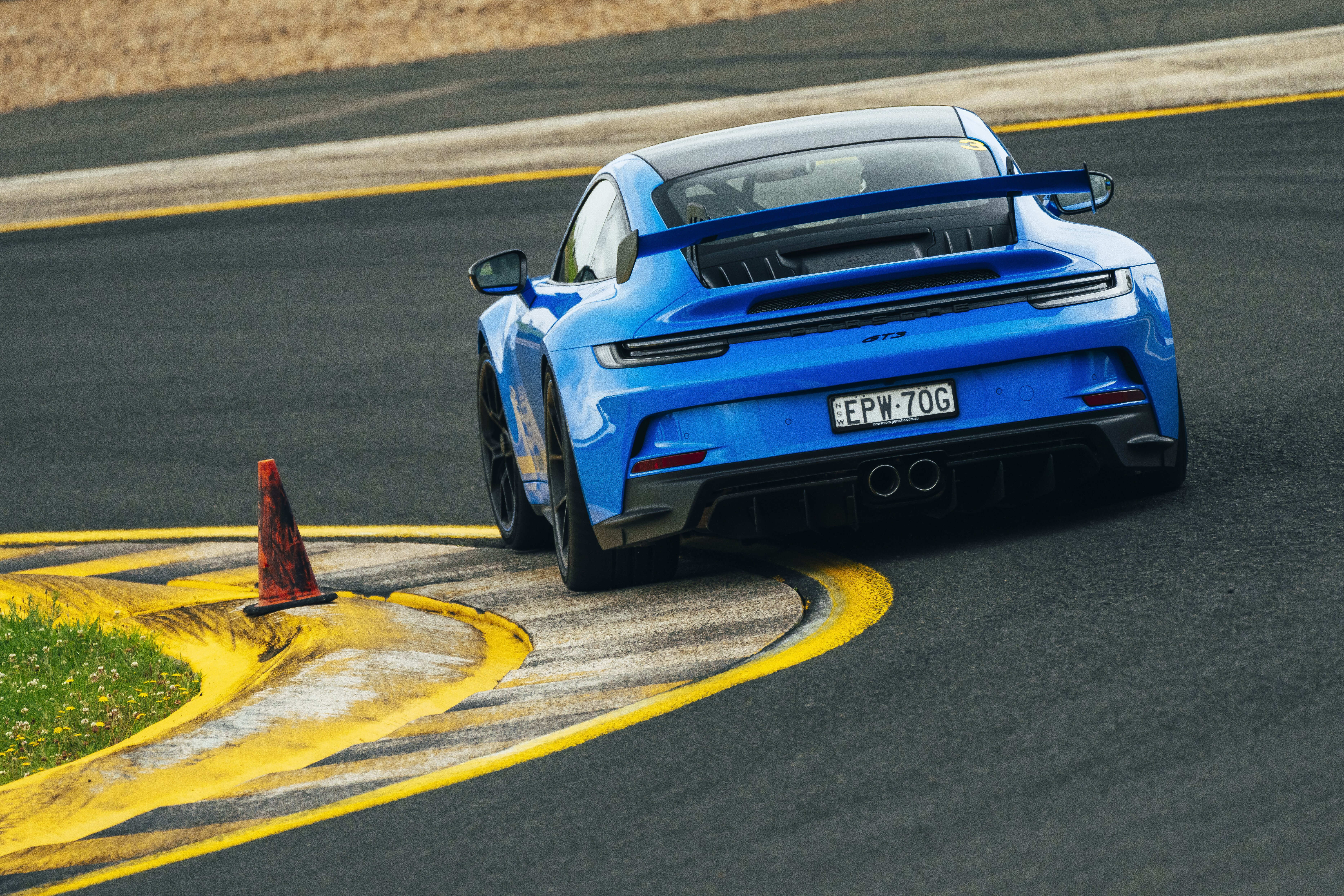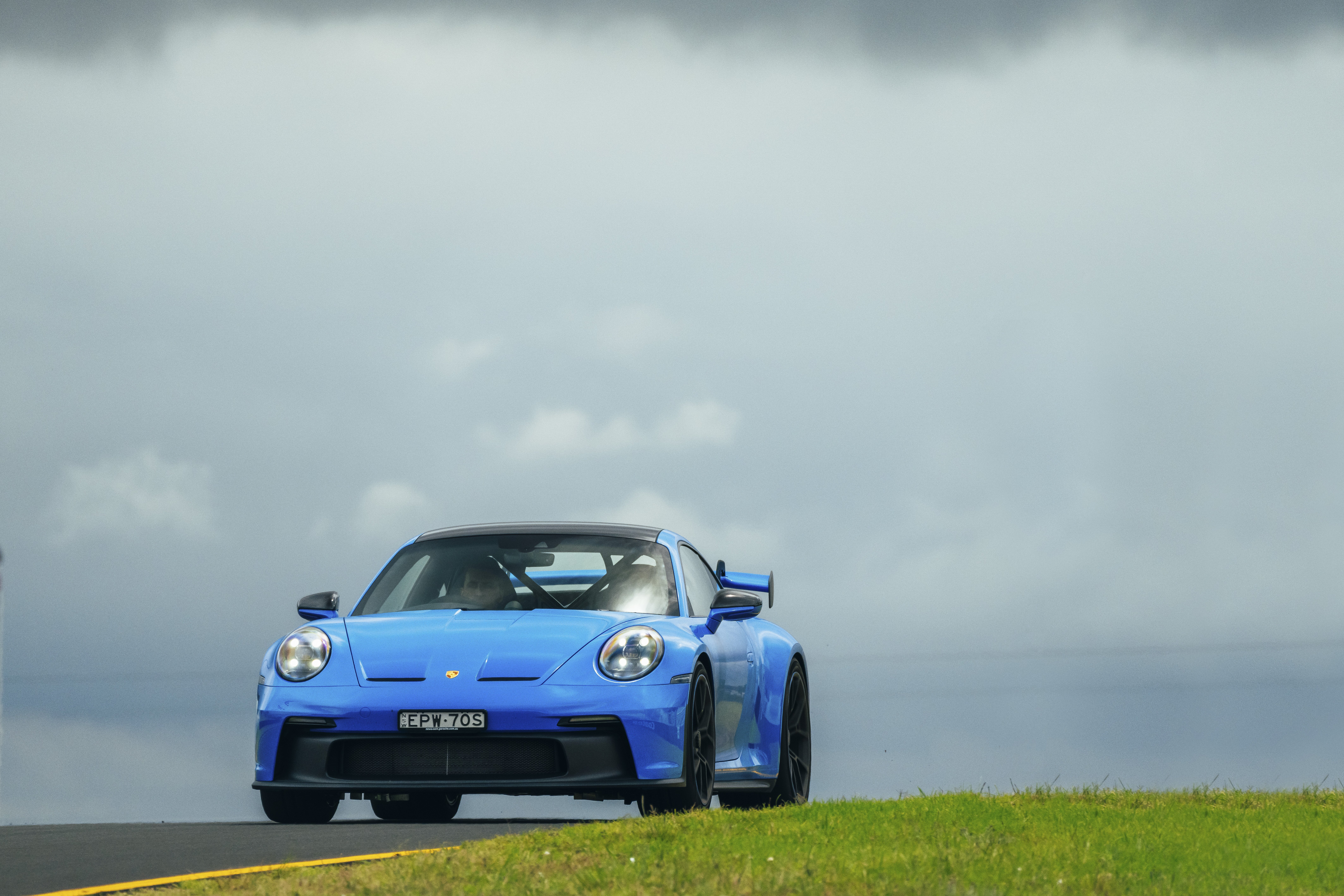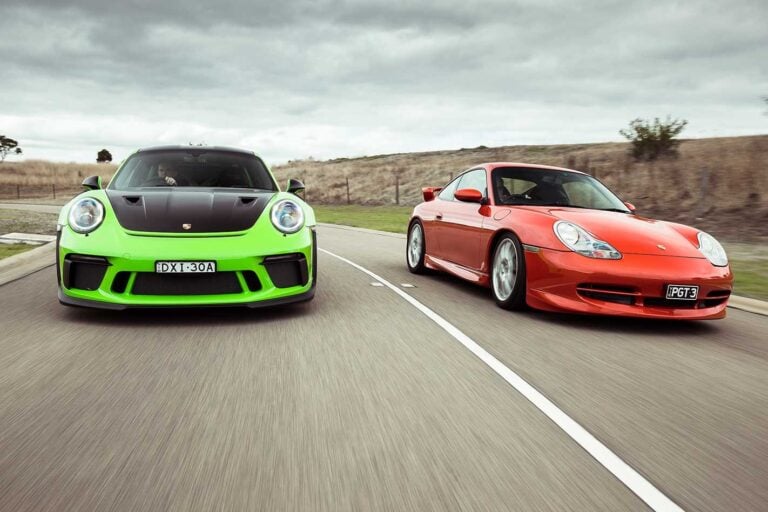Things we like
- Stunning drivetrain
- Engaging dynamics
- Stamina
- More accessible
Not so much
- Hunched driving position
- Engine not as raw
- Price now ~$400K on-road
- Securing an allocation
Even by the standards of the Porsche 911, the new 992-generation GT3 appears to be an evolution of the species. This has always been the case of course, but a quick glance at the spec sheet appears to suggest a particularly small step forward.
Incremental tweaks abound. The 4.0-litre naturally-aspirated flat-six now produces 375kW and 470Nm, increases of 7kW and 10Nm courtesy of the individual throttle bodies first introduced on the limited edition 991.2 Speedster, but the gear ratios in the seven-speed dual-clutch gearbox are the same.

The body is 11mm longer and 8mm taller (width is the same), resulting in a 5kg weight gain. Unsurprisingly, with similar power and weight its performance claims are equally similar, the 0-100km/h time remaining static and the 0-200km/h figure improving by just 0.2sec.
The tyres are 10mm wider at both ends, the front wheels a half-inch wider and the rears an inch bigger in diameter, the front brake rotors are 28mm larger; everywhere you look there are incremental changes, but it does suggest that Porsche is just tinkering around the edges, that it’s run out of ideas somewhat.
The 992 GT3 is 17.5sec quicker around the Nurburgring than its predecessor. Its 6:59.927sec effort is faster even than the previous-gen GT3 RS.

One figure, however, says otherwise. The new 992 GT3 is 17.5sec quicker around the Nurburgring than its predecessor. Its 6:59.927sec effort is faster even than the previous-gen GT3 RS and, if you want a graphic illustration of how far we’ve come in 20 years, a mind-altering 1min1.2sec quicker than the first 996 GT3.
Dig a little deeper and it becomes apparent that Porsche’s GT department, led by the charismatic Andreas Preuninger, has done anything but rest on its laurels. For a larger, stiffer bodyshell with bigger wheels, tyres and brakes to put on only 5kg is quite an achievement. A carbon bonnet helps, as does lightweight glass (both pulled from the GT3 RS ideas cupboard), while the exhaust system is 10kg lighter than before.
Straight-line acceleration may be similar to before, but 0-100km/h in 3.4sec and 0-200km/h in 10.8 sec with a 318km/h top speed is nothing to sneeze at, the slight improvement coming courtesy of a shorter final drive ratio and better aerodynamics.

Manipulation of the air is one area the 992 has taken a big step forward over its predecessor. At the front, the packaging of the nose required the introduction of two nostrils in the bonnet to vent air from behind the central radiator.
At the rear there is the new ‘swan neck’ rear wing. By attaching the supports to the top of the wing, it leaves the downforce-generating underside free to work with the ducktail spoiler and huge diffuser to increase downforce by 50 per cent at 200km/h. Adjust the wing to its track-only ‘Performance’ setting and that figure increases to 150 per cent.
The final piece of the puzzle is virtually invisible, at least until you reveal a front wheel. Every road-going 911 until now – including all 992 models – has used MacPherson strut front suspension, but the new GT3 copies the RSR Le Mans racer by adopting a double-wishbone front end.

It’s made possible by the larger 992 body, but even so, the cost and complexity of installing a completely different front suspension layout on the same production line would’ve taken a few meetings to sort out. It’s a superior performance car solution, providing greater wheel stability under load.
All of this is just letters and numbers on a page, though, knowledge regurgitated from the press kit – research not assessment. Thankfully, we have a day at Sydney Motorsport Park and a trio of identical Shark Blue 992 GT3 PDKs, not to mention a who’s who of Australian racing drivers on hand to ensure that the driver (in this case me) isn’t the weak link in the chain: Luke Youlden, Craig Baird, Alex Davison, Tony D’Alberto and Fabian Coulthard just to name a few.
The final piece of the puzzle is virtually invisible, at least until you reveal a front wheel … the new GT3 copies the RSR Le Mans racer by adopting a double-wishbone front end

Each car is fitted with bucket seats, a half cage and six-point harnesses (though the lap-sash belt suffices), but there are a couple of new additions to the driving environment. The first is electric height adjustment for the seat, which sinks your bum virtually to the floor. In general, the driving position is very good in terms of the arm-wheel/leg-pedal relationship, the brakes located nicely for either left- or right-foot braking, but the bucket seat does force quite a hunched posture, especially with a helmet on.
The interior is simple but high quality, a digital screen either side of the central analogue tacho adding a dash of technology, though the regular 992’s futuristic gearshift toggle has been replaced by what looks like a manual lever, even in these PDK-equipped cars. It allows gears to be changed sequentially as well as via the paddles.

Push the top and pull back to select drive, then tweak the rotary dial on the steering wheel – another new feature – to click through Normal and Sport modes to Track, which alters the engine and gearbox mapping, while the adaptive dampers can be set to Sport (firm) or Track (very firm).
Despite its performance potential, the GT3 isn’t intimidating in the slightest. The steering – still variable ratio but quicker across the board than before – is relatively light without a hint of slack and the immediacy of its responses indicate I’m going to need to push a lot harder to start approaching its limits. A sign of the effortless speed it generates is the fact that while I feel a 1min45sec lap will be a good place to start, the data says my opening salvo is a 1min40.3sec.

There’s still plenty of time to find, but the opportunity to do so is delayed by the arrival of rain. Track-focused cars on wide semi-slick tyres in the wet are usually of similar effectiveness as reading a newspaper in the rain, but while colleagues who bear the brunt of the weather come back a little ashen-faced, on a wet-but-not-puddled track the GT3 is surprisingly capable.
Traction is no longer absolute, but the linear nature of the naturally aspirated engine makes full throttle in second gear still a possibility with a bit of patience. It’s the communication from the front end that really stands out, though. It sticks better than you’d think, but also telegraphs when it starts to relinquish its purchase beautifully.
Despite its performance the GT3 isn’t intimidating in the slightest. The steering is relatively light and the immediacy of its responses indicate I’m going to need to push a lot harder to start approaching its limits.

Happily, the track dries and with increased familiarity comes increased commitment. Outputs of 375kW/470Nm might not raise eyebrows as they once did but the GT3 screams its way to 245km/h down the main straight, the latest noise and emissions regs failing to completely mute the flat-six howl. It’s smoother than the 991 or 997 engines, less visceral, but still music to the ears.
Stability into and through the super-fast turn one is ridiculous, though the otherwise spookily telepathic PDK ’box does get slightly confused, holding fifth through the corner then kicking down to fourth once throttle is reapplied on the exit. It doesn’t upset the car and it’s a problem easily rectified by blipping down to fourth manually during braking.
Those brakes receive a mighty workout into turn two, shedding 140km/h in a little over 100m, but fade is never an issue, at least in our five-lap sessions. Long corners like SMP’s turn two (and three, and four, and seven…) have traditionally been tricky in a 911. Brake too much and the rear will swing wide, brake too little and the front won’t bite; likewise, accelerate too hard, too soon and the front lifts and understeers wide.

This is still the case – physics dictate it with a rear-engined layout – but as with each successive generation of the 911 the 992 manages to further hide these characteristics. Turn the wheel and the front responds, lifting mid-corner usually just tightens the line rather than resulting in some lurid oversteer slide and as long as the throttle isn’t treated like an on-off switch the GT3 generally goes exactly where you point it on corner exit.
If that makes it sound like Porsche’s road racer has become slightly prescriptive and lost some of its edge, then nothing could be further from the truth. It’s probably fair to say that the 992 GT3 is easier to drive quickly than ever, but I’d argue that makes it more rewarding for amateurs without sacrificing its appeal to more experienced punters.

A couple of laps with Youlden on a half-wet, half-dry circuit shows just what the car is capable of in expert hands. It becomes a canvas to which he applies his brush strokes, the GT3 feeling excited to have someone who can exploit it properly behind the wheel. With the help of the instructors, even I manage a 1min38.9sec lap. For context, at PCOTY 2010 Luffy’s best effort in an R35 GT-R (the quickest car there by some margin) was a 1min44.2sec. Yes, 10 years is a long time ago, but equally, I am a long way from Luffy.
At this pace the GT3 comes alive, squirming through turns as the lateral limit is approached but not in a way that erodes confidence; it’s merely telegraphing that it’s beginning to work hard. As is the driver due to the pace you’re travelling at, though happily any indiscretions are quickly mopped up by the PSM stability control system.
It’s probably fair to say that the 992 GT3 is easier to drive quickly than ever, but I’d argue that makes it more rewarding for amateurs without sacrificing its appeal to experienced punters.

While the changes to the 992 GT3 are more extensive than first appears, it is still an evolution of what came before. Would I recommend that 991 or 991.2 GT3 owners rush out and upgrade? Probably not, though equally, if they’ve extracted all they can from their current steeds and want to reset some PBs, the 992 will undoubtedly do so.
You can guarantee plenty of them will occupy pit garages all over the country (and indeed the world) in the months and years to come, for as a machine to drive to the track, hot lap all day then drive home again, it is still virtually without peer. When you’re the dominant species, sometimes a small evolution is all that’s required.
2022 Porsche 911 GT3 specifications
| Body: | 2-door, 2-seat coupe |
|---|---|
| Drive: | rear-wheel |
| Engine: | 3996cc flat-6cyl, DOHC, 24v |
| Bore/stroke: | 102.0 x 81.5mm |
| Compression: | 13.3:1 |
| Power: | 375kW @ 8400rpm |
| Torque: | 470Nm @ 6100rpm |
| Power/weight: | 261kW/tonne |
| Weight: | 1435kg |
| 0-100km/h: | 3.4sec (claimed) |
| Top Speed: | 318km/h |
| Transmission: | 7-speed dual-clutch |
| Suspension: | double-wishbone, coil springs, helper springs, adaptive dampers, anti-roll bar (f); multi-links, coil springs, helper springs, adaptive dampers, anti-roll bar (r) |
| L/W/H: | 4573/1852/1279mm |
| Wheelbase: | 2457mm |
| Tracks: | 1601/1553mm |
| Brakes: | 408mm ventilated/drilled discs, 6-piston calipers (f); 380mm ventilated/drilled discs, 4-piston calipers (r) |
| Wheels: | 20 x 9.5-inch (f); 21 x 12.0-inch (r) |
| Tyres: | 255/35 ZR20 (f); 315/30 ZR21 (f) Michelin Pilot Sport Cup 2 |
| Price: | $369,600 + ORC |
Things we like
- Stunning drivetrain
- Engaging dynamics
- Stamina
- More accessible
Not so much
- Hunched driving position
- Engine not as raw
- Price now ~$400K on-road
- Securing an allocation
We recommend
-
 News
NewsWATCH: 992 Porsche 911 GT3 sets new lap record at The Bend
N/A screamer beats Turbo's time
-
 Features
FeaturesThe 911 generations that helped build the GT3 legend
Everything you need to know about Porsche’s 911 GT3 generations
-
 Features
FeaturesPorsche 996 911 GT3 vs Porsche 991.2 911 GT3 RS comparison: 20 Years of the 911 GT3
The 996 GT3 began a lineage of driving machines that continues with the latest 991.2 GT3 RS






